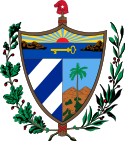- Prime Minister of Cuba
-
Cuba 
This article is part of the series:
Politics and government of
Cuba- Constitution
- Council of State
- First Vice President
- Second Vice President
- Cabinet (Council of Ministers)
- Premier (List)
- National Assembly of People's Power
- President
- Ricardo Alarcón de Quesada
- President
- Supreme Court
- Political parties
- Communist Party of Cuba
- First Secretary
- Communist Party of Cuba
- Elections: 2003, 2008
- Provinces
- Municipalities
- Committees for the Defense
of the Revolution - Opposition
- Human rights
- Foreign relations
Other countries · Atlas
Politics portal
Flag of the Prime Minister
Prime Minister of Cuba was a position in the government of Cuba. Fidel Castro assumed the position of Prime Minister in 1959 replacing José Miró Cardona.[1]
The office was abolished on December 2, 1976 following a restructuring of the government and the implementation of a new Constitution of Cuba. Castro became president of the Council of State (President of Cuba) and president of the Council of ministers, elected by the National Assembly. The Prime Minister of Cuba was also referred to as the Premier. The role of president of the Council of Ministers is sometimes still referred to as the "prime minister".[2]
The role of the Prime Minister was first assigned in 1940 in accordance with the amended Constitution of Cuba. The first Prime Minister of Cuba was Carlos Saladrigas Zayas (1900–1957), the nephew of former President Alfredo Zayas. Between 1940 and 1959 Cuba saw fifteen changes to the position, Félix Lancís Sánchez was Prime Minister twice (1944–1945 and 1950–1951) whilst Fulgencio Batista held the role concurrently alongside that of President of Cuba for one month (April 1952) following a military coup.
See also
Footnotes
- ^ 1959: Castro sworn in as Cuban PM BBC online.
- ^ Country profile: Cuba BBC online
Categories:- Government of Cuba
- Politics of Cuba
- Cuba stubs
- Government stubs
Wikimedia Foundation. 2010.
Look at other dictionaries:
Cuba — This article is about the country. For other uses, see Cuba (disambiguation). Republic of Cuba República de Cuba … Wikipedia
Cuba–Tuvalu relations — relations Tuvalu … Wikipedia
Cuba–Sri Lanka relations — Map indicating locations of Cuba and Sri Lanka Cuba Sri Lanka … Wikipedia
Cuba–Russia relations — Cuba Russia relations Cuba … Wikipedia
Cuba — Cuban, adj., n. /kyooh beuh/; Sp. /kooh vah/, n. a republic in the Caribbean, S of Florida: largest island in the West Indies. 10,999,041; 44,218 sq. mi. (114,525 sq. km). Cap.: Havana. /kooh bah/, n. Cubba. * * * Cuba Introduction Cuba… … Universalium
Cuba–Oceania relations — Cuban Pacific relations are diplomatic, economic, cultural and other relations between the Republic of Cuba and countries situated in Oceania. In the 2000s, Cuba has been strengthening its relations with Pacific nations, which have, for the most… … Wikipedia
Cuba–Vanuatu relations — Vanuatu–Cuba relations Vanuatu … Wikipedia
Council of Ministers of Cuba — The Council of Ministers is the highest ranking executive and administrative body and constitutes the government of the Republic of Cuba. Its membership consists of the President of the Council of ministers (sometimes referred to as the Prime… … Wikipedia
Cuba — • The largest and westernmost island of the West Indies Catholic Encyclopedia. Kevin Knight. 2006. Cuba Cuba † … Catholic encyclopedia
Foreign relations of Cuba — Cuba This article is part of the series: Politics and government of Cuba Constitution Council of State … Wikipedia
